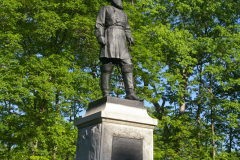Installed before July 1, 1919. Formally dedicated on August 6, 2007.
Location: Culp’s Hill at the intersection of Slocum Avenue and Williams Avenue.
Description: A standing portrait of General Geary resting his proper left hand on his sword. The sculpture rests on a rough granite base adorned with an inscription plaque on the front on a bronze tablet bearing the Pennsylvania state seal on the back. The lower two parts of the shaft are rough hewn with a bronze tablet inset at the front. The monument is one of several that the Pennsylvania State Assembly appropriated money for on July 24, 1913. The memorial cost $6,666.00.
National Park Service List of Classified Monuments Number: MN348.
Sculptor: Schweizer, J. Otto, 1863-1955, sculptor.
About Major General John White Geary
 Born on December 30, 1819 in Mount Pleasant, Pennsylvania, Geary studied law and civil engineering before serving in the Mexican War where he was wounded five times. He was one of the largest generals of the Civil War, standing six feet six inches tall and weighing 260 pounds; all told, he was wounded at least ten times during his military career. After serving in Mexico, Geary was elected mayor of San Fransisco and served as territorial governor of Kansas.
Born on December 30, 1819 in Mount Pleasant, Pennsylvania, Geary studied law and civil engineering before serving in the Mexican War where he was wounded five times. He was one of the largest generals of the Civil War, standing six feet six inches tall and weighing 260 pounds; all told, he was wounded at least ten times during his military career. After serving in Mexico, Geary was elected mayor of San Fransisco and served as territorial governor of Kansas.
Returning east at the outbreak of the Civil War, Geary raised the 28th and 147th Pennsylvania regiments. He served in the Valley and later with the Army of Virginia where he was seriously wounded at Cedar Mountain. His division was heavily engaged at Chancellorsville where he was again incapacitated by wounds.
Geary’s performance at Gettysburg was less than stellar, as he lost track of its division as it was marching into position on Culp’s Hill but escaped public notice as the mistake did not factor into the battle. Geary was transferred with the rest of the XII Corps to the western theater; his son, Edward, was killed at Wauhatchie. He later oversaw the surrender of Savannah.
After the War, Geary served two terms as the governor of Pennsylvania. Shortly after leaving office, he was stricken by a fatal heart attack at the age of only 53. A county in Kansas was named in his honor.







